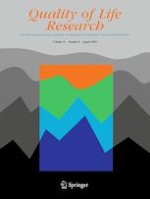06-01-2022
How is your life? understanding the relative importance of life domains amongst older adults, and their associations with self-perceived COVID-19 impacts
Gepubliceerd in: Quality of Life Research | Uitgave 8/2022
Log in om toegang te krijgenAbstract
Purpose
This study aims to provide new knowledge on the relative importance of key life domains amongst older adults, and how the Coronavirus pandemic has influenced their life (domain) satisfaction.
Methods
A cross-sectional survey was administrated to an online panel of the general public aged 65 years and older in Australia from 28 April to 26 May 2020. Life satisfaction was measured by the Personal Wellbeing Index (PWI, including both global life satisfaction and life domain satisfaction). A discrete choice experiment technique was used to elicit how respondents perceive the relative importance of six key life domains drawn from the PWI: standard of living, health, relationships, safety, community connectedness, and future security.
Results
A total of 1,056 respondents (53% female) with a mean (range) age of 73 (65–91) years old completed the survey. After controlling for a rich set of confounding factors, regardless of the choice of overall life satisfaction indicators, there were consistent findings that the strongest negative influence of COVID-19 on life domains and decrements on life satisfaction was for Personal Health, Personal Relationships and Standard of Living. The DCE data revealed that all six life domains were statistically significant in contributing to a better life, and there exists some preference heterogeneity between those who perceived no impact versus negative impacts from COVID-19.
Conclusions
From both revealed and stated preference data there was robust evidence that health, relationships, and standard of living represent the three most important life domains for older adults in Australia.
